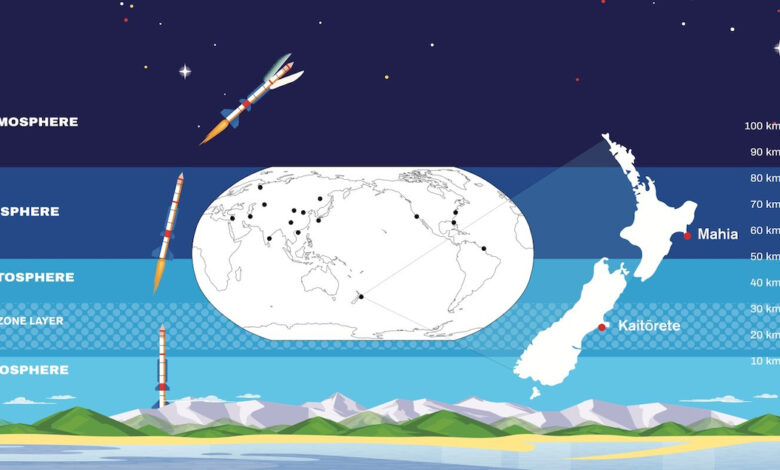Researchers say that rocket launches are damaging the Ozone layer

You may be familiar with the term Ozone Hole, this region of depleted Ozone in the stratosphere happens during Springtime in the in the Antartic region of the Southern Hemisphere. The Ozone layer became a concern in the early 1990s as a result of chlorofluorocarbons (CFCs) and halons that were emitted by chemicals in refrigeration, aerosols, etc.
Thanks to global efforts such as the Montreal Protocol of 1987, the emissions of harmful gases reduced, and the Ozone Hole has begun to recover. Had it not been for that, over 2/3 of the Ozone Layer would have been destroyed by 2025.
But, there is another threat to the Ozone layer, rocket launches. Researchers from the University of Canterbury (NZ) have published their findings in the Journal of the Royal Society of New Zealand, to highlight the impact of gaseous emissions from rocket launches.
When a rocket is launched into Space, it emits gases and particulates, these are released into the middle and lower atmosphere. These gases are harmful for the Ozone layer that protects Earth by absorbing most of the harmful ultraviolet rays from the Sun.
Rise in rocket launches
The aerospace industry has grown rapidly in recent times. A lot of technologies rely on satellites, from telecommunications, scientific research, remote sensing such as weather monitoring, location services, etc. The new iPhone 14 from Apple has a satellite-based Emergency SOS feature. This is just an example of the roles satellites play in our lives today.
An estimate by the Bank Of America in 2017 indicated that the global space industry could be worth 3.7 Trillion U.S. Dollars in 30 years. Likewise, the New Zealand space industry is estimated to be worth almost USD 1 billion by 2025.
This has also resulted in a number of space-based startups being funded heavily. Companies such as SpaceX, Virgin Galactic, Blue Origin are focussing on space tourism. Around 90-130 rockets were launched in the last 5 years, and this is expected to grow further.
How do rocket fuel emissions harm the Ozone layer?
Most rockets that are launched rely on 4 fuel types for propulsion: liquid kerosene, cryogenic, hypergolic and solid. The fuel combustion results in carbon dioxide, water vapour, black carbon, alumina, reactive chloride and nitrogen oxides being released into multiple layers of the atmosphere.
Estimates have indicated that about two-thirds of these emissions are injected above 15 kilometres, in the lower border of the stratosphere. The Ozone layer is part of the Stratosphere, which is approximately 15-50 km above the Earth’s surface, It is home to nearly 90% of the Ozone layer.
There is a stark difference between rocket fuel emissions and other anthropogenic gases and particulates, the latter are either removed in the lowest region of the atmosphere, which is the troposphere. Or, if the live long enough, these gases may reach the upper layers through natural circulation. Rocket emissions are removed similarly, and fuel afterburning (secondary combustion) further reduces the impact. But, the stratosphere could allow the emission products to last longer, and these smaller concentrations could have a bigger destructive effect on the Ozone layer. The re-entry of rocket components also results in producing nitrogen oxide gases.
What can be done to reduce these emissions?
The researchers have called for propulsion teams to consider estimating the emission factors as part of their optimisation process for fuel efficiency and design of the rockets. This could help in gathering real-world emission measurements. In-situ measurements, and help collect data to research the impact of the emissions.
In-situ measurements, direct samples, targeted campaigns, stratospheric plume measurements, could help future studies, and predictive modeling. The report is available at Taylor and Francis, in the form of a web article, PDF and an EPUB. The researchers suggest normalization of emissions data availability which could serve as a benchmarking tool for understanding the atmospheric impact of the rocket launchers. They have also recommended providing the information in a database form or part of the licensing process for launch providers.
Image courtesy: Tandfonline.
Dr Laura Revell, an associate professor in environmental physics at the University of Canterbury, and co-author of the study said (via Cosmos) that Ozone recovery has been a global success story, and that future rocket launches should continue that sustainable recovery. She also stated that while the current impact of rocket launches on the ozone layer is small, it has the potential to grow as space programmes and companies grow in scale.
Thank you for being a Ghacks reader. The post Researchers say that rocket launches are damaging the Ozone layer appeared first on gHacks Technology News.
gHacks Technology News
